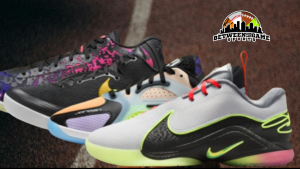Written by Will Johnson June 24, 2025
“Is it the Shoes?” A famous saying from NBA JAM, a video game that kids who grew up in the 90’s know all too well. Nowadays, that question is synonymous with injuries occurring in the NBA, more specifically, ACHILLES TEARS. Here’s just my two cents about it.
Today’s sneakers are designed for performance, but not always for injury prevention. Lightweight, bouncy shoes can improve speed and agility, but they may also reduce the structural support that older models provided. Everyone wants to be more bouncy or more shifty, but at what cost? This past playoffs, we saw stars like Damian Lillard, Jayson Tatum, and finally Tyrese Haliburton in the FINALS go down. If you glance at their shoe game, they all are similar in style and design. In the last decade, the NBA has seen a shift from bulky high-tops to low-top and mid-cut shoes. While low-tops allow more freedom of movement and speed, they offer less protection to the ankle and Achilles area. For a player making violent cuts or sudden stops, this can increase the risk of overextension or rupture. Additionally, the hardwood floors NBA players compete on are more tightly constructed now, meaning less shock absorption. Combine that with hours of training on hard concrete or synthetic courts in the offseason, and it’s a recipe for tendon stress.
shift from bulky high-tops to low-top and mid-cut shoes. While low-tops allow more freedom of movement and speed, they offer less protection to the ankle and Achilles area. For a player making violent cuts or sudden stops, this can increase the risk of overextension or rupture. Additionally, the hardwood floors NBA players compete on are more tightly constructed now, meaning less shock absorption. Combine that with hours of training on hard concrete or synthetic courts in the offseason, and it’s a recipe for tendon stress.
Here’s a thought: How about players get with a foot specialist and combine that with shoe companies? The NBA and players have the means to do this if they are not doing it already. Every player is not built the same, so every player should not have a similar-style shoe. A guard-style shoe built for speed and flexibility may not be ideal for a 250-pound forward who moves explosively. It’s kinda like how they do in the NFL with linemen; they have different types of braces and cleats compared to, say, a wideout. If the shoe doesn’t match the biomechanics of the player (foot type, gait, movement style), it can increase tendon stress.
 Modern shoe companies are into selling shoes, bottom line, and that’s not their fault. It’s a business, but the long-term health has to be a part of the thought process. You have to have athletes play in those shoes so protect your product. Traction, bounce and aesthetics are the driving force behind shoe sales, but long-term tendon health, particularly for the Achilles, is often not a design priority. I wonder what the research shows for these companies with health and sales.
Modern shoe companies are into selling shoes, bottom line, and that’s not their fault. It’s a business, but the long-term health has to be a part of the thought process. You have to have athletes play in those shoes so protect your product. Traction, bounce and aesthetics are the driving force behind shoe sales, but long-term tendon health, particularly for the Achilles, is often not a design priority. I wonder what the research shows for these companies with health and sales.
Final thoughts, Achilles tears in the NBA aren’t just bad luck. They’re a byproduct of an evolving game that pushes the human body to its absolute limit. Until there’s a shift in how players train, rest, and recover (that’s another article to be discussed with injuries), we may continue to see even more stars sidelined by this devastating injury. Make no mistake about shoes and their designs are part of this ugly trend moving forward. We need to see more personalized fitting shoes, more research on players’ style, body type, and so much more. LET’S NOT LET THE SHOE GAME CONTINUE TO HURT THE GAME.

